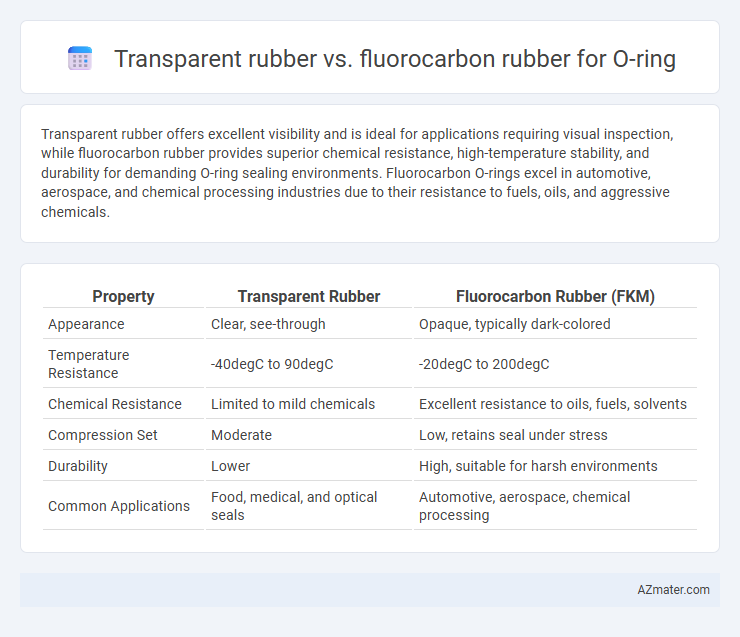Transparent rubber offers excellent visibility and is ideal for applications requiring visual inspection, while fluorocarbon rubber provides superior chemical resistance, high-temperature stability, and durability for demanding O-ring sealing environments. Fluorocarbon O-rings excel in automotive, aerospace, and chemical processing industries due to their resistance to fuels, oils, and aggressive chemicals.
Table of Comparison
| Property | Transparent Rubber | Fluorocarbon Rubber (FKM) |
|---|---|---|
| Appearance | Clear, see-through | Opaque, typically dark-colored |
| Temperature Resistance | -40degC to 90degC | -20degC to 200degC |
| Chemical Resistance | Limited to mild chemicals | Excellent resistance to oils, fuels, solvents |
| Compression Set | Moderate | Low, retains seal under stress |
| Durability | Lower | High, suitable for harsh environments |
| Common Applications | Food, medical, and optical seals | Automotive, aerospace, chemical processing |
Introduction to O-Ring Materials
O-ring materials like transparent rubber and fluorocarbon rubber serve distinct purposes based on their chemical properties and application environments. Transparent rubber offers excellent visual inspection capabilities and flexibility, making it ideal for non-critical sealing where chemical resistance is less demanding. Fluorocarbon rubber is favored for its superior heat resistance, chemical inertness, and durability in harsh environments, especially in automotive, aerospace, and industrial sealing applications.
What is Transparent Rubber?
Transparent rubber is a clear elastomer known for its excellent clarity and flexibility, commonly used in applications requiring visibility and aesthetic appeal alongside sealing functionality. Fluorocarbon rubber differs significantly, offering superior chemical resistance, high-temperature tolerance, and durability ideal for harsh environments where transparency is not essential. Transparent rubber O-rings are preferred in low-impact, non-corrosive settings, while fluorocarbon O-rings suit demanding industrial applications requiring robust performance.
What is Fluorocarbon Rubber?
Fluorocarbon rubber (FKM) is a high-performance elastomer known for its exceptional resistance to heat, chemicals, and oil, making it ideal for O-ring applications in harsh environments. Unlike transparent rubber, which offers visual clarity and moderate chemical resistance, fluorocarbon rubber provides superior durability and sealing capability under extreme temperatures up to 250degC and exposure to aggressive fuels, solvents, and acids. Its unique fluorine-based molecular structure ensures long-lasting performance, reducing maintenance needs and enhancing reliability in automotive, aerospace, and industrial sealing solutions.
Key Properties of Transparent Rubber O-Rings
Transparent rubber O-rings offer excellent clarity and high elasticity, making them ideal for applications requiring visual inspection and flexible sealing. They provide strong resistance to water, ozone, and moderate chemicals but generally exhibit lower chemical and heat resistance compared to fluorocarbon rubber O-rings. Key properties include transparency, good compressibility, and compatibility with various fluids, yet they are less suitable for high-temperature or aggressive chemical environments where fluorocarbon rubber excels.
Key Properties of Fluorocarbon Rubber O-Rings
Fluorocarbon rubber O-rings exhibit exceptional chemical resistance, particularly against fuels, oils, acids, and solvents, making them ideal for harsh industrial environments. Their outstanding thermal stability allows operation in a wide temperature range from -26degC to 204degC, outperforming the limited durability of transparent rubber O-rings. Superior compression set resistance and low gas permeability contribute to the long-term sealing performance and reliability of fluorocarbon rubber in critical applications.
Chemical Resistance Comparison
Fluorocarbon rubber O-rings exhibit superior chemical resistance against a wide range of aggressive chemicals, including oils, fuels, solvents, and acids, making them ideal for harsh industrial environments. Transparent rubber O-rings generally offer lower resistance and can degrade when exposed to strong chemicals, limiting their use to applications requiring visibility and moderate chemical exposure. The fluorocarbon's high molecular stability and strong carbon-fluorine bonds provide enhanced durability, outperforming transparent rubber in both longevity and performance under chemical stress.
Temperature Performance Comparison
Transparent rubber O-rings typically withstand temperatures ranging from -40degC to 90degC, offering moderate heat resistance suitable for general applications. Fluorocarbon rubber O-rings excel in high-temperature environments, maintaining integrity from -26degC up to 230degC and providing superior chemical and heat resistance in demanding industrial settings. The temperature performance difference makes fluorocarbon rubber ideal for applications requiring prolonged exposure to extreme heat, while transparent rubber is preferred for moderate temperature sealing needs.
Applications: Transparent vs Fluorocarbon O-Rings
Transparent rubber O-rings are ideal for applications requiring visibility and chemical resistance, such as food processing, medical devices, and optical equipment, where contamination detection is critical. Fluorocarbon rubber O-rings excel in high-temperature environments and exposure to aggressive chemicals, making them suitable for automotive, aerospace, and industrial sealing applications. Their superior chemical resistance and thermal stability enable reliable performance in harsh conditions where transparency is not a priority.
Cost and Availability Considerations
Transparent rubber O-rings generally offer lower cost and higher availability due to widespread manufacturing and common applications, making them suitable for budget-sensitive projects. Fluorocarbon rubber O-rings, although more expensive, provide superior chemical resistance and durability, resulting in limited but specialized availability primarily in high-performance industrial sectors. Choosing between these materials depends heavily on balancing upfront cost constraints against long-term performance needs and procurement accessibility.
Choosing the Right O-Ring Material for Your Needs
Transparent rubber O-rings provide excellent visibility and are ideal for applications requiring visual inspection or light transmission, but they may have limited chemical resistance compared to fluorocarbon rubber. Fluorocarbon rubber O-rings offer superior resistance to high temperatures, fuels, oils, and aggressive chemicals, making them suitable for demanding industrial environments. Selecting the right O-ring material depends on factors such as chemical exposure, temperature range, and the need for clarity or mechanical durability.

Infographic: Transparent rubber vs Fluorocarbon rubber for O-ring
 azmater.com
azmater.com